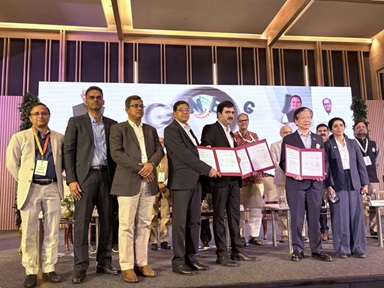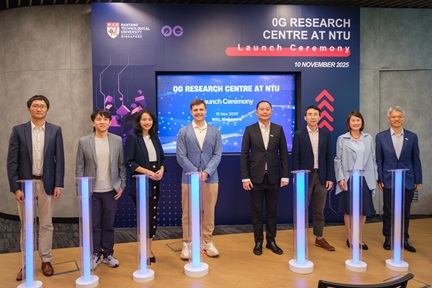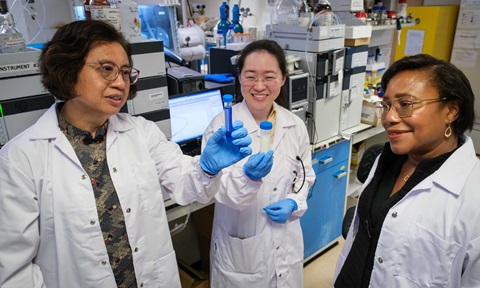Multi-material printer enables quick and easy 3D printing of flexible devices
 Image: (L-R) Members of the multi-material 3D printer team include Co-leader, Dr Low Mun Ji, General Manager, Panasonic; Dr Suchand Sandeep, Research Fellow, NTU School of Mechanical and Aerospace Engineering (MAE); Dr Nicholas Tham, Senior Research Engineer, Panasonic; Co-leader, Associate Professor Murukeshan Vadakke Matham, NTU School of MAE, Singapore Centre for 3D Printing; Dr Joel Lim, Research Engineer, Panasonic, and Mr Daryl Lim, Research Associate, NTU School of MAE, with the newly developed printer in the background. Assoc Prof Murukeshan is holding onto a sample of a 3D printed stretchable pressure sensor.
Image: (L-R) Members of the multi-material 3D printer team include Co-leader, Dr Low Mun Ji, General Manager, Panasonic; Dr Suchand Sandeep, Research Fellow, NTU School of Mechanical and Aerospace Engineering (MAE); Dr Nicholas Tham, Senior Research Engineer, Panasonic; Co-leader, Associate Professor Murukeshan Vadakke Matham, NTU School of MAE, Singapore Centre for 3D Printing; Dr Joel Lim, Research Engineer, Panasonic, and Mr Daryl Lim, Research Associate, NTU School of MAE, with the newly developed printer in the background. Assoc Prof Murukeshan is holding onto a sample of a 3D printed stretchable pressure sensor.
Scientists from NTU, Panasonic Factory Solutions Asia Pacific Pte. Ltd. (Panasonic), and Singapore Centre for 3D Printing (SC3DP) have developed a new multi-material printer using multi-wavelength high-power lasers, for quick and easy 3D printing of smart, flexible devices.
The multi-material printer works by utilising varying wavelengths of laser, creating thermal and chemical reactions capable of transforming common carbon-based materials (polyimide and graphene oxide) into a new type of highly porous graphene. The resulting structure printed with this new graphene is not only light and conductive, but it can also be printed or coated onto flexible substrates like plastics, glass, gold and fabrics, creating flexible devices.
Electronic devices and components have traditionally been comprised of rigid materials such as metals, silicon, and ceramics, but there has been an increasing interest in the creation of flexible wearable electronics that can be bent, twisted, and easily conformed to various surfaces.
Co-leader of the project, Associate Professor Murukeshan Vadakke Matham from NTU School of Mechanical and Aerospace Engineering (MAE) and SC3DP, the national centre of excellence in 3D printing housed at NTU, said: “Our project aims to find a way to 3D print new materials like organic polymers and carbon-based materials like graphene, which has properties that allow them to be printed or coated onto flexible substrates like plastics or fabrics, creating flexible and stretchable circuits.”





.tmb-listing.jpg?Culture=en&sfvrsn=cfde9c58_1)

